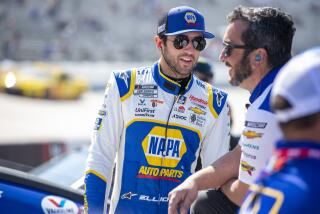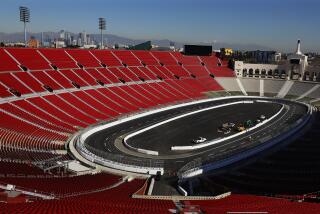NASCAR is facing a world of change
“Everywhere around the world, they’re coming to America.”
So sang Neil Diamond, years ago, in a song that still resonates.
Change one word, make it, “They’re coming to NASCAR,” and you’ve got what may be the beginning of a trend in motor racing.
From Formula One, Colombian Juan Pablo Montoya is here, and Canadian Jacques Villeneuve is pondering migration. Two top drivers from America’s top open-wheel series, 2006 Indianapolis 500 winner Sam Hornish Jr. and Champ Car sensation A.J. Allmendinger, are on their way.
Hornish and Allmendinger are Americans, but are coming in from series that are international -- Champ Car in its schedule, and the Indy Racing League with its high population of imported drivers.
From as far a field as motocross, 15-time champion Ricky Carmichael has signed a developmental contract with a NASCAR team.
At Homestead-Miami Speedway during this final weekend for NASCAR’s top three series, Hornish and Montoya plan to compete in the Busch race, and Allmendinger and Montoya will try to qualify for the Nextel Cup race.
Next season and beyond, there almost certainly will be more, with nationality no longer a consideration.
“Let me tell you why they’re looking,” said Jeff Gordon, who has mingled in recent years with the multiple racing cultures outside NASCAR. “They’re not coming to drive NASCAR because they think these cars are great fun to drive and the most exciting cars out there.
“They’re coming because this is where the money’s at. They also see that it’s really cool racing. You’ve got a lot of side-by-side, very competitive racing. And I think some guys say, ‘Hey, I’ve conquered this; now I want to conquer that.’ That’s great. But this is where the money’s at.”
Allmendinger, the sudden star in Champ Car who rolled off five quick wins this season and then bolted to NASCAR, bears that out.
Formula One was Allmendinger’s goal, and he was using Champ Car as a springboard. Then, when he was offered a reported three-year, $9-million deal with the formative Red Bull Toyota team that will begin Nextel Cup competition next year, Allmendinger changed plans.
“When you get in here, if you’re popular or if you do well, you’re going to make good money,” Gordon said.
So Allmendinger, who has shown potential in truck races, could double his money with merchandise sales, to maybe $18 million over the next three years. This for a 24-year-old who has yet to drive a Cup race.
At the top of Formula One, Fernando Alonso and Kimi Raikkonen easily make more than that in a season. So you’ll never see them bail out of their enormous salaries and ultra-engineered rides. And seven-time champion Michael Schumacher, who retired after the 2006 season, had only recently yielded his title as the world’s highest-paid athlete to golfer Tiger Woods.
But from the second echelon on back, even Formula One is vulnerable.
“For me, this was the right chance to take and it would be crazy for me to turn it down,” Allmendinger said.
“In NASCAR, whether it’s Nextel Cup or the Busch ranks or the truck ranks or even in ARCA [an affiliated stock car series], there’s just a lot more opportunity for a driver to get in a seat, make a living and get their name recognized.
“In open-wheel racing, there’s only 17 or 18 cars in each series, and it’s tough to get in there and get your name recognized and get a ride.”
But some worry that NASCAR, even with 43 starting spots for each race, might become overcrowded, what with the onrush of talent, new manufacturers such as Toyota, new teams such as Red Bull and new corporate sponsors.
Ed Hinton covers auto racing for Tribune papers.
More to Read
Go beyond the scoreboard
Get the latest on L.A.'s teams in the daily Sports Report newsletter.
You may occasionally receive promotional content from the Los Angeles Times.










